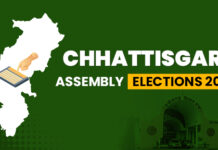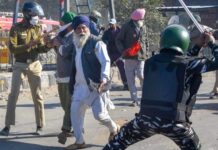Even after a week has passed, Uttar Pradesh (UP) assembly election results are being publicly discussed. Barring mainstream media channels that predicted a clear majority for Bhartiya Janta Party (BJP+ got 273 seats), socio-political circles in Lucknow and Delhi are still trying to figure out the electoral defeat of Samajwadi Party alliance (SP+ got 125 seats) and decimation of Bahujan Samaj Party (BSP) to a single seat that used to dictate the subaltern landscape of largest and politically most significant state in India. A large section of independent media and social media outlets that were predicting an anti-BJP wave across the state is now hiding in closet. Wishful thinkers, academicians, and scribes have resorted to blaming the voters for voting against the opposition alliance.
A couple of post-poll studies (like CSDS-Lokniti and Arvind Kumar) tried to explain how people voted for BJP but none of them could break the jinx of caste divisions. Traditionally, sociological and ethnographical studies weigh upon caste more than class. Going by the CSDS-Lokniti data, we could see that BJP has not only increased its Hindu voters but also gained 8 percent of Muslim voters in this election. Among Hindu voters, it has not only retained its upper caste support but fairly dented the OBC and SC electorate.

But it is not ‘how people voted’ that is haunting the informed citizenry. The question that has remained unanswered is ‘why people have voted for BJP’. This question is central to the discourse.
The fundamental question
To put this in perspective, one must recall the horrors of consecutive lockdowns that witnessed a large-scale reverse migration of workers in 2020 and a huge number of deaths in 2021. The first lockdown saw 19448 FIR’s in the first month of its imposition where 60,258 people were booked under Section 188 of IPC and Epidemic Act. The second lockdown in 2021 saw roughly 23000 deaths in UP according to official figures. But upon analyzing the mortality data obtained under the Right to Information act, the deaths in UP districts with the highest official caseload were between 10 to 335 times higher than the government’s data on COVID deaths from July 2020- 31 March 2021.

The number of registered educated unemployed in UP stood at 21.39 lakh as of June 30, 2018. By February 7, 2020, this data reaches to 33.93 lakh registered unemployed people. This amounts to a 58.43 percent growth in the number of unemployed people in the state in the last two years. The CMIE data further states that the unemployment rate in the state increased to 21.5 per cent in April 2020, during the first lockdown due to the COVID-19 pandemic. One can imagine what two years of consecutive pandemics and resulting lockdown wreaked havoc on peoples lives and livelihoods.
Pandemic-related woes and mismanagement on one hand, the impunity with which the incumbent government under Yogi Adityanath carried out targeted encounter killings forced NHRC and Supreme Court to take cognizance at one point. Then, bulldozing the properties of the mafia in a targeted manner was another aspect of this lawlessness. This impunity extended to demanding compensation and seizures from anti-CAA protesters across the state. This lawlessness reflects in the killing of 12 scribes during five-year tenure and around 150 cases of physical attacks on journalists, not to mention the illegal detention and arrests that stretched up to false bookings under dreadful UAPA and NSA. The complete scenario of civil liberties under the Yogi regime turned into a nightmare for anyone who dared to speak.
In a nutshell, the whole spectrum of constitutional values i.e. freedom, equality, fraternity, and justice seemed to turn upside down during five-years of the BJP regime in Uttar Pradesh. This resulted in several protests and ground-level agitations from various sections of contract employees, government workers, teachers, medical personnel, and even home guards. The situation was ripe for a regime change. Wishful thinkers were not incorrect in predicting an anti-BJP wave. The bipolar character of elections that I had predicted in an earlier article was not a myth. But the final result was counter-intuitive!
This counter-intuitiveness embedded in the final figures released on March 10th is a matter of great speculation and curiosity across the state. A pertinent question must be asked at this stage: Why disadvantaged voters cast their votes in favor of a party that represents the policy interests of the wealthy? This question may lead us into the changing patterns of class as well as caste hierarchies in Uttar Pradesh during the last two decades of liberalism and privatization where the state has ultimately become the custodian of elite (caste and class elites) power.
The ‘beneficiary’ factor
Much has been talked of the so-called ‘beneficiary’ factor in the context of UP elections. This is nothing new, seems easy to grasp but many complexities are involved in resorting to using it as a tool to understand BJP’s fortunes. Since the concept of a welfare state was decisively thrown away by late nineties, all political parties in India have been regularly trying to woo voters by distributive politics in two ways: (a) Private provision of local public goods; (b) Manipulation of public resources in a program-oriented manner.
Tarique Thachil of Yale University says that privately financed electoral strategies, outside of some forms of direct vote-buying, have received comparatively scant scholarly attention from scholars of the global south. Most studies of distributive politics have instead focused on how parties can manipulate public resources to their political advantage. Yet, for actors who are largely in opposition, including elite parties, strategies that require public resources are not a viable initial option.

In his painstakingly written book “Elite Parties, Poor Voters: How Social Services win votes in India”, Thachil says that the BJP’s experience shows that making services locally public enables individual providers to establish contact with a relatively large number of poor voters. Meanwhile, the monetary expenses of welfare can be kept relatively low by providing only the most rudimentary of services. Provisions like free ration, money, gas cylinders, etc. that have been much publicized during election campaigns of BJP were joint product of two factors:
Thachil writes:
“…its demand (as an elite party) for a non-threatening strategy of poor voter recruitment and its supply (as a party founded by a social movement) of thick organizational resources. My theoretical argument anticipates private welfare to prove similarly attractive to all political actors with elite core constituencies. However, only those elite formations that are also endowed with thick organizational resources will prove capable of implementing this painstaking approach. The most substantively important examples of such parties across Asia and Africa are those that are tied to religious social movements”.
BJP is one such party that fulfills all these pre-conditions. This strategy is not exactly an exchange of goods for support but a multidimensional social process that has unfolded across several stages in Indian polity. He writes:
“Activists in India (read RSS) have converted this everyday contact into electoral returns by patiently earning voter goodwill, rather than by enforcing quid pro quo clientelist protocols. Service providers converted this goodwill into electoral returns among beneficiaries and some non-beneficiaries through the networks of friends and associates they developed and through their own powers of rumor and suggestion as apolitical residents of high local standing”.
In this context, the role of RSS in BJP’s electoral success is one point that has been completely missed by analysts this time.

The other point that has been overlooked is the decaying presence of the Bahujan Samaj Party in rural UP that once proved influential in politicizing lower caste identities but did not also compel an equivalent broadening of social provisioning. Thachil writes based on his field experiences in UP and Chhattisgarh: “Thus, Uttar Pradesh constitutes a blend of a sharply politicized subaltern community (akin to Kerala’s) and inadequate basic service provisioning (similar to Chhattisgarh’s)”. This subaltern community was mobilized by BSP in a top-to-bottom manner that helped resist RSS’s overtures in the rural landscape until the late nineties. As BSP lost hold of its cadres and subaltern classes, RSS with its provisioning services made inroads. This process has come almost full circle in this election with BSP losing 22 percent Jatav and 17 percent of other SC votes.
To conclude with Thachil’s comments:
“In addition to balancing the material concerns of rich and poor, service proved remarkably rhetorically malleable. This flexibility enabled Hindu nationalists to simultaneously sell the strategy to three sets of actors: skeptical lower caste communities, fretful upper-caste supporters, and an ideologically committed activist core”.
These three sets of actors can easily be identified on the basis of caste distribution in the CSDS chart if CSDS data is to be believed.
Other considerations
There are other considerations too, like EVM tampering, voter list manipulation, etc. that have been used to explain BJP’s victory in UP. For the sake of anti-EVM activists, simplistically, even if 70 seats could be attributed to tampering or fraud , it still requires valid arguments to explain the simple and clear majority. These factors alone cannot explain the counter-intuitiveness of results.
To sum up, the Hindutva card of BJP mixed with private provisioning of social benefits through RSS and its private affiliates is the single most convincing factor that justifies the 2022 verdict. This has happened because the only cadre-based party BSP gradually lost socio-political ground in rural areas where it previously used to act as a bulwark against RSS. Other parties like SP and Congress did not have sufficiently thick organizational built and vision to counter the mixed strategy of BJP. Neither they had any political vision or program apart from mimicking BJP in announcing freebies which never works when you are in opposition.
Opposition parties need to re-think their strategies and programs if they seriously want to ouster BJP from power.
The author is senior journalist and editor of junputh.com





























